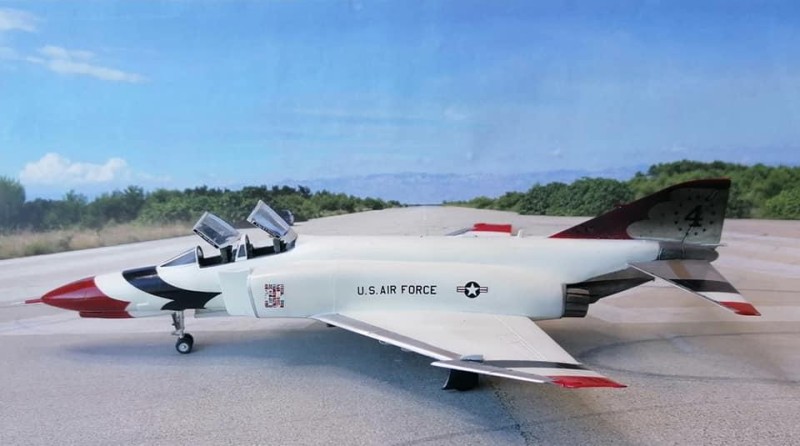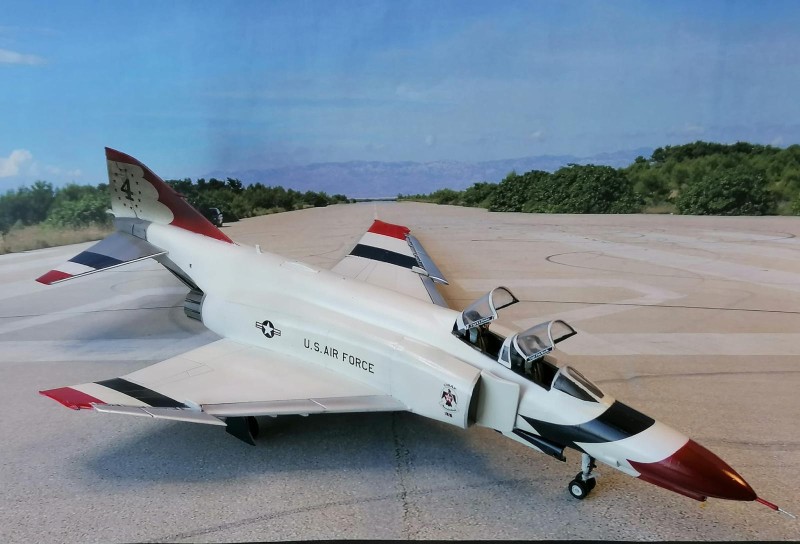1969 F-4E Phantom II Thunderbird; Hasegawa 1/72
This article is part of a series:
Thunderbirds Phantom II F-4E
Hi fellow modellers,
Proceeding my Thunderbird series, I post a quite old build that I've missed before.
The Phantom II F-4E
Hope you like,
A white T-bird
The Thunderbirds started the 1969 training season still in the F-100Ds, but in the spring of that year, received the first of the new McDonnell Douglas F-4E Phantom IIs and began the team's conversion. The F-4's conversion was the most extensive in the team's history. Among several other modifications, the paint scheme changed due to the variations in chemicals, which allows paint used on the F-4 to resist heat and friction at Mach II speeds. As a result, the white paint base was developed and remains a part of today's Thunderbird aircraft design.
This would be the only period in which both the Thunderbirds and Blue Angels would fly the same aircraft. However, the Phantoms supplied to the T-Birds had originally been painted camouflage green and therefore had to be painted over in white with the traditional team markings on top of that. Though this extra paint added an additional 800 pounds to an already 20 ton monster, it established a new paint scheme which all later T-Bird aircraft would follow.
The added weight had little effect on flying the Phantom because, as Thunderbird Crew Chief Mike Jacobssen would later write: “No airplane in Thunderbird history has the hair-on- the-chest brutality of the F-4. Like the B-52, the F-4 was not a machine called 'she.'” However, this power came at a high cost -- in fuel. Accordingly, when the fuel crisis came in the early 1970s and the Blue Angels simultaneously had several accidents in their Phantoms, “we were guilty by association” according to T-Bird Maintenance Supervisor Roger Hemme. Because five T-38 Talons could fly on the fuel used by a single F-4E -- and because for political purposes the military had to show it was “conserving” energy like everyone else -- the Thunderbirds transitioned to the Talon in 1974.
A sooty #4
One of the jets always had a very distinctive variation on this livery, with a black tail. There's a very good reason for why the "slot" jet, the aircraft assigned to fly in the position right behind the lead plane, was colored this way and why the individual at the controls invariably became known as 'Captain Carbon.'
The kit
At the time of my build, there was not many 1:72 F-4E kits, so I went with the old Hasegawa. It's an old kit, with a lot of fitting problems and lack of detail.
I managed to get some decals but, they were so bad that I ended up painting all the livery. It's just a matter of masking and spraying paint 😀
Cheers,








This is an amazing build, Manuel! Really great that you decided to share this older build with us, not only because of the build itself, but also for the really nice info regarding the use of the F-4 by the T-birds, the characteristics of the paint and, equally importantly importantly, the story behind the sooted #4!
Congratulations!
Thanks Spiros! @fiveten
Too kind as usual.
Stay safe my friend
Very nice showbird.
Thank you! ?
‘Hope you like it’?
Love it! Lovely job with the masking and painting.
If that’s the kit I’m thinking about, it brings back many memories - my first F-4E kit that I found at a flea market many moons ago.
1 attached image. Click to enlarge.
Hi George, thanks for your kind words. Mine was a regular F-4E, from the same era, I guess 🙂
Great job on the paint job (especially the "black tail") and the story. As a young 2Lt going through USAF Pilot School at Williams AFB, AZ in 1971, I got to meet and spend some time with the T-Bird pilots when they came for our annual airshow. They were great guys and spent a lot of time talking (and drinking beer) with us fledgling pilots. Capt. Jerry Bolt was the #4/Slot pilot at that time. I was having some problems learning two-ship formation flying (it's harder than it looks) and was worried about my progress in the program. Jerry told me to just relax and don't overthink what I was trying to do. He said it was like riding a bicycle or Zen...just trust and it will "happen". This was years before "Star Wars", but it was like "trusting the force"...it worked. Jerry was a great guy. Sadly, he was killed in an accident the next year performing a routine maintenance functional check flight on one of their F-4's.
Wow... Thank you, Sir. @trod348
That's the kind of story that make this plastic 'alive'. I love when this happens 😀
Thanks for sharing
Very nice T-bird! I got to see the Phantom show back in the early 70's at Craig AFB in Alabama. Quite the auditory experience when they all come roaring over at low altitude!
Thanks Greg! Never had that chance :-/
An absolute stunning build, Manuel @magrus
Was not aware that the T-birds also used the F4, it must have been overwelming to see those aircraft passing in formation.
You did great on this kit, no signs of fitting problems like you mentioned.
Have to admit that you did a great job on the paintwork as well.
Thanks @Johnb!
Yes, they did! It must have been a sight...
This kit took me a lot of work and time, but it's on display with the rest of the family 🙂
1 attached image. Click to enlarge.
Beautiful picture @magrus
Love the reflection at the bottom.
Looks great, the old kit holds up well and you did great job on the paint scheme!
Thanks Robert, you're very kind!
Absolutely...WONDERFUL.
Thank you!
I was 8 years old in 1972 when I saw the Thunderbirds perform in the F-4E. Really rocked my world! When I saw them #4’s fin was totally black as if it had been painted black. Great build! Thanks fo sharing.
Hi Jim! @angus64
Thank you for your feedback.
Yes, I've seen photos and references of a totally black tail, but I think that it's a build up process during the season. Nevertheless, I choosed to represent it this way to help telling the story.
I'm glad it brought memories and you liked it.
M
Yes, I agree that the soot was built up over the season. It was July when I saw them, so well into their schedule.